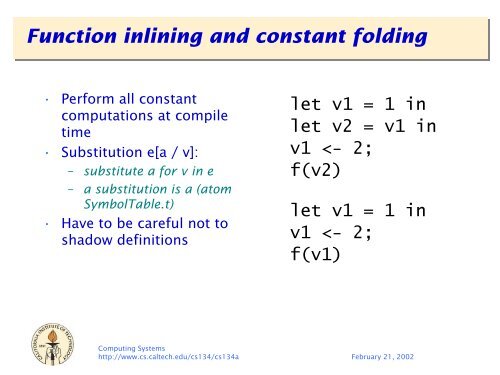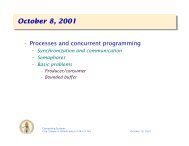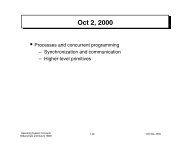Create successful ePaper yourself
Turn your PDF publications into a flip-book with our unique Google optimized e-Paper software.
<strong>Function</strong> <strong>inlining</strong> <strong>and</strong> <strong>constant</strong> <strong>folding</strong>• Perform all <strong>constant</strong>computations at compiletime• Substitution e[a / v]:– substitute a for v in e– a substitution is a (atomSymbolTable.t)• Have to be careful not toshadow definitionslet v1 = 1 inlet v2 = v1 inv1
Inlining• FIR: substitution is always valid• First, characterize values that may be inlined(** Available expressions.*)type avail =AvailVar of var| AvailAtom of atom| AvailClosure of var * var * avail| Avail<strong>Function</strong> of var * bool * var list * exp| AvailRecord of vartype arecord = avail FieldTable.ttype aenv ={ aenv_vars : avail SymbolTable.t;aenv_records : arecord SymbolTable.t}Computing Systemshttp://www.cs.caltech.edu/cs134/cs134a February 21, 2002
“Available” expressions• The aenv contains an available expression foreach var v– AvailVar v’: simple case, variable v is available as var v’– AvailAtom a: variable v can be replaced by a– AvailClosure (v’, f, arg) variable v is defined as a closure(f, arg), v’ contains its value– Avail<strong>Function</strong> (v’, force, f, args), variable v is a functionf(args), v’ contains its value, force is set if <strong>inlining</strong>should be forced– AvailRecord v’: variable v is a record defined in theavailable records as v’Computing Systemshttp://www.cs.caltech.edu/cs134/cs134a February 21, 2002
Inlining LetAtom• LetAtom can always be inlined<strong>and</strong> inline_atom_exp aenv pos v a e =let pos = string_pos "inline_atom_exp" pos inlet avail = aenv_lookup_atom aenv a inlet aenv = aenv_add aenv v avail ininline_exp aenv eComputing Systemshttp://www.cs.caltech.edu/cs134/cs134a February 21, 2002
Constant <strong>folding</strong>• Perform <strong>constant</strong> arithmetic at compile time<strong>and</strong> inline_unop_exp aenv pos v ty op a e =let pos = string_pos "inline_unop_exp" pos inlet v' = new_symbol v inlet a = inline_atom aenv a inlet a' =match op, a withUMinusIntOp, AtomInt i ->AtomInt (-i)| UMinusFloatOp, AtomFloat x ->AtomFloat (-.x)| ...inlet aenv = aenv_add_atom aenv v a' inlet e = inline_exp aenv e inLetUnop (v', ty, op, a, e)Give a new name to the varPerform <strong>constant</strong> <strong>folding</strong>Inline the restComputing Systemshttp://www.cs.caltech.edu/cs134/cs134a February 21, 2002
Constant <strong>folding</strong>• Have to be careful:– is compiler arithmetic the same as run-time?• Example: OCaml uses 31 bit ints, Java uses 32• we’ll ignore this for now– what about divide by zero?• may be ok to flag error at compile time• if not, do not inline division by 0Computing Systemshttp://www.cs.caltech.edu/cs134/cs134a February 21, 2002
Conditionals• Conditionals can be evaluated too<strong>and</strong> inline_if_exp aenv pos a e1 e2 =let pos = string_pos "inline_if_exp" pos inmatch inline_atom aenv a withAtomBool true ->inline_exp aenv e1| AtomBool false ->inline_exp aenv e2| a ->let e1 = inline_exp aenv e1 inlet e2 = inline_exp aenv e2 inIfThenElse (a, e1, e2)Computing Systemshttp://www.cs.caltech.edu/cs134/cs134a February 21, 2002
<strong>Function</strong> <strong>inlining</strong>• Inline “small” functions• Initial IR usually has very small functions (1-5instructions)• Have to be careful to avoid code blowup– Don’t inline recursive functions– Be careful about <strong>inlining</strong> in conditionalsComputing Systemshttp://www.cs.caltech.edu/cs134/cs134a February 21, 2002
<strong>Function</strong> “size”(* These don't cost anything *)LetVar (_, _, a, e)| LetAtom (_, _, a, e) ->size_exp fenv size e(* Cheap expressions *)| LetSubscript (_, _, _, _, e)| LetProject (_, _, _, _, e)| LetArray (_, _, _, _, e) ->size_exp fenv (succ size) eComputing Systemshttp://www.cs.caltech.edu/cs134/cs134a February 21, 2002
<strong>Function</strong>s: unknown definition<strong>and</strong> inline_tailcall_exp aenv pos f args =let pos = string_pos "inline_tailcall_exp" pos inlet rec inline aenv f args =match aenv_lookup aenv f withAvailVar f ->TailCall (f, List.map atom_of_avail args)Computing Systemshttp://www.cs.caltech.edu/cs134/cs134a February 21, 2002
<strong>Function</strong>s: closure• Recursively inline the closure| AvailClosure (_, f, arg) ->inline aenv f (arg :: args)Computing Systemshttp://www.cs.caltech.edu/cs134/cs134a February 21, 2002
<strong>Function</strong>: function def| Avail<strong>Function</strong> (f', force, vars, body) ->let aenv =if force thenaenvelseaenv_add_id aenv f'in"Forced" functions remain inavailable setOtherwise, remove the bodylet aenv = aenv_add_args aenv pos vars args ininline_exp aenv bodyComputing Systemshttp://www.cs.caltech.edu/cs134/cs134a February 21, 2002
Common-subexpression elimination• Some computations may be performed multipletimes (without side-effects)– May be introduced by programmer (perhapsunintentinally)– May be introduced during IR generation• Fold them togetherwhile(i < 10) {a[j + i] = a[j + i] + a[i];i++;}Computing Systemshttp://www.cs.caltech.edu/cs134/cs134a February 21, 2002
CSElet loop (j, i) =if i < 10 thenlet v1 = j + i inlet v2 = a[v1] inlet v3 = a[i] inlet v4 = v2 + v3 inlet v5 = j + i ina[v5]
Structuring CSE• FIR invariants– Each variable has one def– Let-definitions have no side-effects– Two expressions compute the same value if they havethe same code• Simple CSE– Fold all identical let-definitions• Problems:– Sub-optimal: are “x + y” <strong>and</strong> “y + x” the same?– Memory dereferences: memory ops are not functionalComputing Systemshttp://www.cs.caltech.edu/cs134/cs134a February 21, 2002
Operations that can be folded• LetAtom (can be totally eliminated)• LetUnop• LetBinop• Address-of (LetAddrOfSubscript,LetAddrOfProject)• LetClosureComputing Systemshttp://www.cs.caltech.edu/cs134/cs134a February 21, 2002
CSE Algorithm• Keep a table of full-exp<strong>and</strong>ed expression treesfor each let-definition– expr_table: exp -> var• For each foldable let-definition– Calculate its full-exp<strong>and</strong>ed expression tree– If expression tree is in the table, use the existing valuein a LetAtom definition– If not, add the let definition to the table, keep existingcodeComputing Systemshttp://www.cs.caltech.edu/cs134/cs134a February 21, 2002
Expression treestype cse =CseAtom of atom| CseUnop of unop * cse| CseBinop of binop * cse * cse| CseClosure of var * cse listComputing Systemshttp://www.cs.caltech.edu/cs134/cs134a February 21, 2002
Computing expression treeslet v1 = i + j in(i + j) -> v1let v2 = v1 + k in((i + j) + k) -> v2let v3 = j + k in(j + k) -> v3let v4 = i + v3 in (i + (j + k)) -> v4 (<strong>and</strong> v2?)...Computing Systemshttp://www.cs.caltech.edu/cs134/cs134a February 21, 2002
CSE• Data structure: (cse -> var) Table– In practice, naïve CSE is pretty successful– Use table equality to generalize <strong>folding</strong>Computing Systemshttp://www.cs.caltech.edu/cs134/cs134a February 21, 2002
CSE equalitylet rec compare_exps e1 e2 =match e1, e2 withCseAtom a1, CseAtom a2 ->compare_atoms a1 a2| CseUnop (op1, e1), CseUnop (op2, e2) ->let i = Pervasives.compare op1 op2 inif i = 0 thencompare_exps e1 e2elseiComputing Systemshttp://www.cs.caltech.edu/cs134/cs134a February 21, 2002
CSE Expression table• Use a normal table with expression comparisonmodule CseCompare =structtype elt = cselet compare = compare_expsendmodule CseTable = Mc_map.MakeTable (CseCompare)Computing Systemshttp://www.cs.caltech.edu/cs134/cs134a February 21, 2002
CSE Algorithm• When a let-definition is encountered– Compute expression tree– Look it up in CseTable– If Not_found• Keep the let-definition, add it to CseTable– Otherwise• let-definition becomes LetAtomComputing Systemshttp://www.cs.caltech.edu/cs134/cs134a February 21, 2002
CSE Binop case<strong>and</strong> cse_binop_expr venv pos v ty op a1 a2 e =let exp = CseBinop (op, CseAtom a1, CseAtom a2) inmatch venv_lookup_exp venv pos exp withSome a, exp ->let venv = venv_add_var venv v exp inLetAtom (v, ty, a, cse_expr venv e)| None, exp ->let venv = venv_add_var venv v exp inLetBinop (v, ty, op, a1, a2, cse_expr venv e)Computing Systemshttp://www.cs.caltech.edu/cs134/cs134a February 21, 2002
CSE Lookup• Fully-exp<strong>and</strong> the expression• Look it uplet venv_lookup_exp venv pos exp =let exp = exp<strong>and</strong>_exp venv pos exp inlet a =try Some (AtomVar (CseTable.find venv.cse_exps exp)) withNot_found ->Noneina, expComputing Systemshttp://www.cs.caltech.edu/cs134/cs134a February 21, 2002
CSE Recursive expansion• Variables are already full-exp<strong>and</strong>edlet rec exp<strong>and</strong>_exp venv pos e =match e withCseAtom (AtomVar v) ->venv_lookup_var venv pos v| CseAtom _ ->e| CseUnop (op, e) ->CseUnop (op, exp<strong>and</strong>_exp venv pos e)| CseBinop (op, e1, e2) ->CseBinop (op, exp<strong>and</strong>_exp venv pos e1, exp<strong>and</strong>_exp venv pos e2)| ...Computing Systemshttp://www.cs.caltech.edu/cs134/cs134a February 21, 2002
Classes, Interfaces, <strong>and</strong> Records• In FIR, we reduce classes <strong>and</strong> interfaces to recordstype record_class =RecordFrame| RecordClass| RecordMethods| RecordObject| RecordVObjecttype ty =...(* TyRecord is a collection of fields *)| TyRecord of record_class * field_types...(* FieldTable is the nonoverloaded FieldMTable *)<strong>and</strong> field_types = ty FieldTable.tComputing Systemshttp://www.cs.caltech.edu/cs134/cs134a February 21, 2002
Records• The “record_class” describes what kind of record– RecordFrame: introduced during closure conversion– RecordClass: a vma record for a class (includes a“names” record)– RecordMethods: a vma record for an interface (just acollection of methods)– RecordObject: an object record• The first field points to a RecordClass• The rest of the fields are the object’s fields– RecordVObject:• A two-element record (vma + this) for a vobjectComputing Systemshttp://www.cs.caltech.edu/cs134/cs134a February 21, 2002
Other record info• FieldTable– Just like a FieldMTable, but it does not have externalnames (FIR does not use external names)Computing Systemshttp://www.cs.caltech.edu/cs134/cs134a February 21, 2002
Upcasts• In addition to VMA, store a “name” tableclass A { ... }RecordObject RecordClass TyNamesnew B: b_vma b_namesinterface C { ... }interface D { ... }class Bextends Aimplements C, D{ ... }b_vmafields...b_namesmethods...FjObject nilA nilB nilC b_c_vmaD b_d_vmanil nilComputing Systemshttp://www.cs.caltech.edu/cs134/cs134a February 21, 2002
Our solution• Interface objects include an interface VMA, <strong>and</strong> an object• Coercions are more expensive (although still <strong>constant</strong>time), method lookup is <strong>constant</strong> timeRecordMethodss_c_vmaRecordVObjectVObject(S)Object Cc_vmac.fb.gs_c_vmaobjectc_vmac_fields...b.zb.gb.hc.fComputing Systemshttp://www.cs.caltech.edu/cs134/cs134a February 21, 2002
FIR conversion• CPS <strong>and</strong> record conversion are performedsimultaneously• To convert a class_info– Allocate the names record• from the class_parents <strong>and</strong> class_interfaces– Allocate the vma record• From the class_methods– Define the object record type• From the class_fieldsComputing Systemshttp://www.cs.caltech.edu/cs134/cs134a February 21, 2002
Class/interface projections• This is the only other interesting conversion• When projecting an object field– Just project it• When projecting a method– Double projection:• Project the vma• Project the method• When projecting a vobject method– Another double projection• For LetProjObject– Project the object from the recordComputing Systemshttp://www.cs.caltech.edu/cs134/cs134a February 21, 2002





